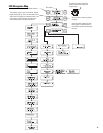
15
Monitor Chain connection.
See explanation, at left.
In
Out
Monitor Chain
The MONITOR CHAIN connector is a 5-pin terminal block connector. Input and output connec-
tions are balanced. The center pin is the shield connection for both the input and output of the
monitor chain. Connection is shown at right. The left-most + and - terminals are for monitor chain
input signals, while the right-most terminals are for monitor chain output signals. When powered
down, a relay connects the input to the output, thus bypassing the BASIS 922dz in the monitor
chain.
RS-232
The RS-232 is an optional utility serial port for accessing advanced features. Connect to an avail-
able COM port on your PC and communicate using a terminal control program such as Windows
Hyperterminal.
Use a normal serial data cable with a DB-9 male plug to connect to the BASIS 922dz. To connect
the cable, orient the connector properly, then push into the receptacle until it is firmly seated;
tighten the retaining screws “finger tight”. Communications should be 9600 baud, no parity, 8
data bits, 1 stop bit, and flow control Xon/Xoff.
Ports
PORT A through PORT D are QSC DataPorts. When using the BASIS 922dz with QSC DataPort-
equipped amplifiers or QSC DSP products (DSP-3, DSP-4) connect to the BASIS 922dz using QSC
DataPort cables. The 922dz supports up to eight channels of DataPort audio and amplifier status
monitoring. This can be four 2-channel amplifiers or one 8-channel amplifier or other suitable
combinations. If connecting a multi-DataPort amplifier, be sure to connect all the DataPorts to the
same BASIS. This practice assures proper amplifier reporting in QSControl.net.
To connect the cable, orient the connector properly, then push into the receptacle until it is firmly
seated; tighten the retaining screws “finger tight”.
LED Indicators
When the BASIS 922dz is plugged into a properly functioning AC outlet, it will power up and
briefly display a welcome screen on the LCD display.
POWER Indicator- This blue indicator illuminates when the BASIS 922dz is plugged into a prop-
erly functioning AC source. There is no power switch on the BASIS 922dz. This helps to prevent
accidental system shutdowns.
DIAGNOSTIC Indicator- This red diagnostic LED reports several possible operational condi-
tions. During boot-up, it is used to continually blink a “dot-dash” pattern if the power-on memory
self-test fails. During normal operation, if any non-recoverable system fault occurs, the diagnos-
tic indicator will remain on, requiring a power restart. If this condition persists, contact QSC’s
Technical Services for assistance.
The diagnostic LED is also used to indicate an update is in progress during a remote firmware
update cycle. First, the LED will blink slowly, indicating the memory erase cycle, then it will blink
rapidly, indicating the memory write cycle. NOTE! During a firmware update, it is critical
the unit remain powered on for the entire process in order to complete successfully.
The diagnostic LED may also be controlled by using the QSControl.net software. This feature is
particularly helpful for identifying a particular unit.
(continued, next page)


















